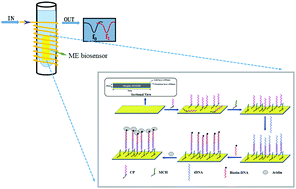Real-time and label-free detection of VKORC1 genes based on a magnetoelastic biosensor for warfarin therapy
Abstract
Various thrombotic disorders have been treated with the anticoagulant warfarin. However, a small change in warfarin concentration may lead to drug adverse reactions or therapeutic failure due to its narrow therapeutic index. Therefore, the dose of warfarin must be monitored for each patient during therapy in real-time and in a sensitive and stable manner. In this work, we designed a magnetoelastic (ME) biosensor using Metglas alloy 2826 to detect VKORC1 genotypes, which is one of the most important known genetic determinants of warfarin dosing. The sensor enabled both fast responses to DNA binding and wireless transmission of signals. Specifically in the target recognition layer, the sensor introduced an avidin–biotin interaction system for signal amplification by increasing the surface load mass. The resonance frequency shift of the signal was linear to the concentration of the target in the range of 0.1 fM to 10 pM, with a detection limit (LOD) of 0.00389 fM (S/N = 3) and a sensitivity of 45.7 Hz pM−1. Importantly, this ME-based biosensor was small and portable without the use of any optical labels, which has high potential to be applied in advanced biomedical diagnosis of nucleic acids and proteins.

- This article is part of the themed collection: Responsive Materials for Healthcare Diagnostics


 Please wait while we load your content...
Please wait while we load your content...